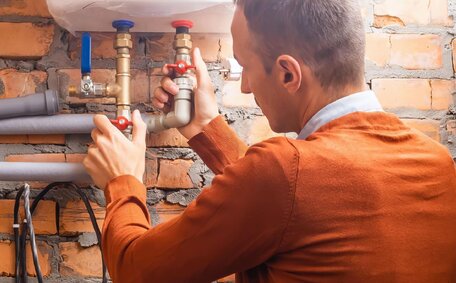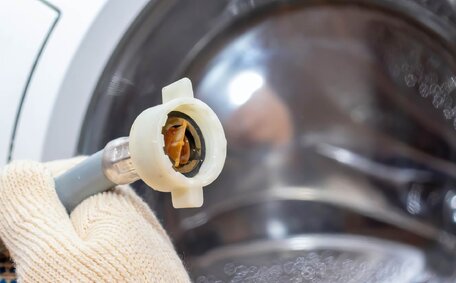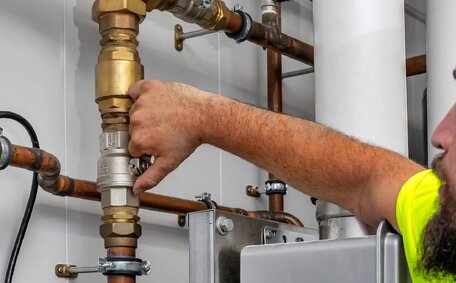Introduction to Cooking with Gas
Cooking with gas offers several key benefits cooking gas over electric stoves that make it an appealing option for many home chefs. Gas stoves provide more precise temperature control, faster cooking times, and more even heat distribution - allowing you to sear, simmer, or stir fry with ease.
The open flame also enables more versatile cooking techniques not possible on a flat electric stove top.
Here at Saint Marys Plumbing, we specialise in the safe installation and maintenance of gas ranges and appliances.
As your local plumbing experts, we want to ensure your home’s gas line and gas range meet strict safety standards while delivering high performance. With over a decade of experience, our licenced gas fitters can advise whether gas or electric works best for your cooking needs and budget.
In this article, we’ll break down the pros, cons, and differences between both gas electric stoves to help you make an informed choice for your kitchen.
Precise Temperature Control
One of the greatest advantages gas stoves offer over electric is precise temperature control. With gas, opposed to an electric range, you can quickly and accurately adjust the size of the flame through the knob dials to reach your desired cooking level. This allows for more nuanced heating tailored to the recipe, which is one more reason to use gas for delicate food preparation.
The immediate temperature response from gas cooking stoves while cooking makes techniques like simmering sauces or frying eggs far easier. You don’t have to contend with hotspots or uneven heating like on some electric cooktops.
Learn more about the benefits where the open flame can elegantly embrace the curves of your cookware, allowing precise heat control for your culinary creations.
So when a recipe calls for a delicate simmer or a high rolling boil, stoves can have their individual merits but gas allows you to achieve the right temperature with ease. Whether you’re thawing frozen ingredients, melting chocolate, or preparing soups, stews, and curries, that accurate control delivers perfect results where electric falls short.
For gas stoves, the added precision expands your options in the kitchen. You have the flexibility to manage different heat levels, allowing you to cook a wide variety of dishes that require special attention to temperature.
Instant Flame Adjustments
One great perk of gas stoves is the instant adjustments available right at your fingertips. You can swiftly dial up or dial down the strength of the flame using the knobs to reach your target cooking temperature.
This real-time heat control stands in stark contrast to electric cooktops. Unlike with gas stoves and ovens, which can outpace any other method including electric stovetops in speed, electric variants require you to wait for the heating element to warm up or cool off—slowing you down considerably. But gas instantly responds to your inputs, letting you adapt to the moment-by-moment needs of your dish.
So when you’re cooking and tempering chocolate, blanching vegetables, or stir frying meat, needing careful regulation, gas stoves excel over electric. You have the flexibility to quickly tweak the temperature as needed without losing time waiting for an electric burner to catch up.
That agility of a gas stovetop lends itself well to maintaining optimal conditions too. The instant tweaks on stoves ovens let you prevent food from over or undercooking as you monitor its progress. You can promptly respond to any temperature changes for the best possible results.
Faster Cook Times
One excellent benefit gas stoves provide is markedly faster cook times compared to electric models. The instant high heat from the open gas flame delivers more energy into pots and pans. This allows food in your pots and pans to cook much faster than gas rivals, boiling water in around half the time.
That instant heat transfer is a considerable advantage over options that take longer to heat up, such as electricity. You spend less time waiting around for elements to warm up just to get cooking. And recipes that typically take longer on an electric stove can be several minutes faster with gas.
From stir fries to steaks and more, gas cooktop appliances achieve quicker results across a variety of dishes. That time saving really adds up over weeks and months of cooking meals. It also provides efficiency for commercial gas kitchens churning out food at pace.
Even Heat Distribution
One of the best aspects of gas stoves is the even distribution of heat they provide. Gas burners emit flame completely around your pots pans, ensuring the sides receive equal exposure. This contrasts with heating dynamics of electric coils where the heat can be more uneven than electricity in a gas stove.
That uniform heating circulation in gas stoves ovens leads to thoroughly cooked meals without hot or cold spots. Meats, vegetables, baked goods - everything heats evenly from bottom to top. Your dishes can easily achieve consistent textures and flavours all the way through with gas cooking.
The balanced heat also prevents food from burning on the pan surface while remaining underdone inside. Stews, roasts, casseroles, and more turn out perfectly cooked to the centre without scorching.
For frying eggs, searing steaks, baking casserole dishes, or preparing any recipe needing an evenly heated surface inside oven, gas stoves excel. You’ll enjoy peace of mind knowing heat reaches food uniformly for ideal results.
Lower Operating Costs
When it comes to daily operation, gas stoves generally cost less than electric models. One of the benefits gas appliances offer is converting fuel to heat at over 60% efficiency, while most electric ranges convert only around 30% of the electricity consumed.
This improved efficiency translates into notable savings over time, especially when compared to electric oven options. Households who understand the benefits cooking with gas can offer tend to spend less per year on fuel than those using electric stoves.
When it comes to fuel costs, natural gas prices also continue to stay relatively low compared to electricity. This further widens the cost difference between gas ovens and electric ones. And for your commercial kitchen churning out meals, every bit of saving on gas costs adds up.
With lower operating expenses, discerning how much gas stoves provide in value becomes evident for your cookware dollar. The savings often offer the opportunity to channel funds towards other kitchen upgrades or appliances. When it comes to equipping your home with premium cooking tools, gas stoves allow you to do so without breaking the bank.
Gas Stove Options and Features
When selecting a gas stove, you have several options to consider that can accommodate different cooking needs and kitchen spaces.
Freestanding ranges are often the way go for many, offering more power with higher BTU commercial-grade burners and larger oven capacity. They allow ample room for large cookware and come in sleek stainless steel. Great for serious home cooks.
Slide-in ranges provide a built-in look for a cleaner aesthetic. Feature-packed models have convection cooking, air frying, griddles, and WiFi connectivity. Perfect for renovated kitchens.
In the debate of gas vs electric, Professional-style stove ranges can also mimic commercial appliances with sturdy construction and restaurant-grade performance. These stove oven combos cater best to cooking enthusiasts with heavy demands, offering the power and versatility of gas cooking.
Outdoor gas grills conveniently allow you to cook with flame outside. Choose from basic to luxury models with side burners, griddle plates, and rotisserie kits.
No matter your priorities, there’s a well-designed gas stove available to becomes the centrepiece of your culinary space. Our gas fitting experts can help find your perfect match.
Comparing Gas and Electric Stoves
When weighing up gas versus electric stoves, there are tradeoffs to consider regarding performance, costs, and environmental factors.
Gas stoves tend to offer superior cooking control with instant temperature adjustments and rapid heat times. The open flames also allow for more versatile cooking techniques. However, rather than an induction stove, they produce higher CO2 emissions from natural gas and may negatively impact indoor air quality.
Electric stoves provide a flat and safe surface that can accommodate more cookware sizes. But they suffer from uneven heating and slower temperature response. Electric models generally have a lower carbon footprint but cost more to operate long-term.
Ultimately, when comes to choosing, the decision often hinges on the priorities and cooking style of each home cook.
Commercial kitchens lean towards gas for speed and heat output. Households focused on sustainability may opt for induction or radiant electric ranges. For most though, a natural gas range remains the gas way go for those seeking precise control.
As your local specialists, Saint Marys Plumbing can elucidate the benefits of cooking with gas, advising you based on your unique cooking needs, budget, and kitchen layout. We professionally install gas lines and service both gas electric stove types to the highest safety standards.
Energy Use and Efficiency
When it comes to energy efficiency, gas stoves are generally more effective than electric models. Gas transfers heat directly from burning fuel to cookware, wasting less energy in the process. Up to 60% of the supplied gas gets converted into usable heat.
Electric stoves, conversely, must first transform the electricity into heat, utilising heating elements such as coils or radiant plates. This intermediate conversion squanders over 70% of the supplied energy before reaching pots and pans. So most electric stoves max out around 30% efficiency.
That improved heat transfer lends gas cooking major efficiency advantages. Gas stoves heat up quicker, can boil water twice as fast, and consume less fuel per use. That efficiency provides real savings over time - especially for commercial kitchens.
Cooking natural gas, similar to LPG, also emits less greenhouse gases than grid-sourced electricity per British thermal unit (BTU) of heat produced. So opting for cooking with natural gas stoves over electric can reduce the carbon footprint of your culinary activities.
With better efficiency, quicker performance, and lower emissions, natural gas stoves offer effective energy use overall. Saint Marys Plumbing, a proud partner of NW Natural, expertly installs efficient gas lines and appliances to maximise energy savings for local homes and businesses.
Cost Savings
Cooking with gas provides noticeable cost savings over electric stoves. Natural gas prices have remained relatively low, while electricity rates continue rising year over year.
Gas stoves and specifically the gas oven channel over 60% of fuel into direct oven heat. But electric models max out around only 30% efficiency during the two-part conversion from electricity to heat. This improved efficiency helps lower your utility expenses.
The instant flame control of gas additionally ensures precision while youre cooking, helping prevent overcooked meals. You don’t waste energy heating up an electric coil that stays hotter for longer. So you get your savings by using less fuel and reducing waste.
Over months and years of household cooking, those added up savings from gas make a real difference. Saint Marys Plumbing can install efficient gas lines and stoves to start maximising those cost benefits for your home.
Environmental Considerations
When it comes to the environment, cooking with gas does have some drawbacks to consider. The primary issue is that gas stoves emit higher levels of air pollutants like nitrogen dioxide (NO2) and carbon monoxide (CO) indoors.
According to the EPA, cooking with natural gas stoves account for over a quarter of all NO2 exposure in homes, largely because gas combustion releases these pollutants into the air. Long-term exposure to such air pollution has been linked to an increased risk of childhood asthma and other respiratory issues.
Gas cooking also indirectly emits carbon dioxide and methane contributing to climate change. Greenhouse gas emissions, such as CO2 and methane, are released during the production and transport of natural gas fuel. Though less than electric models per unit of energy, gas stoves still carry a CO2 footprint from any fossil fuel reliance.
Make sure to mitigate the air quality impacts by having gas burners turned off when not cooking and employing proper ventilation. Modern range hoods filter out pollutants while newer gas stove models emit lower emissions. Getting older appliances serviced regularly also helps minimise any health risks.
At Saint Marys Plumbing, we expertly install range hoods and maintain gas stoves to high safety standards. As your local plumbers, we keep both environmental and health considerations top of mind for your household.
Indoor Air Quality and Health Effects
Using gas for cooking contributes to poorer indoor air quality from releasing nitrogen dioxide, carbon monoxide, and other pollutants. These emissions can negatively impact respiratory health, especially for sensitive groups like children and asthma sufferers.
According to EPA estimates, over 50% of homes in America have gas stoves which can increase indoor NO2 levels far beyond public health standards. Exposure to nitrogen dioxide irritates airways, reduces lung function, and worsens conditions like asthma or COPD over time.
Carbon monoxide is another dangerous component emitted when cooking with LPG or burning fuels like natural gas. In high concentrations, CO prevents the blood from carrying oxygen effectively and can lead to asphyxiation. Using stove ventilation hoods is essential for safe cooking especially when using LPG or other gas fuels.
While concerning, simple steps can reduce risks substantially when cooking lpg or other fuels. Always use range hoods when cooking, keep gas appliances properly maintained, and consider upgrading to cleaner hybrid or induction electric models. As your local experts, Saint Marys Plumbing helps households balance performance with air quality.
Tips for Safe and Efficient Gas Cooking
To ensure safe and efficient gas cooking in your Saint Marys home, follow these essential tips:
- Always use your range hood vent when cooking to remove pollutants
- Have gas fittings inspected annually and get appliances serviced regularly
- Turn burners off promptly when done cooking to save energy
- Clean burners and reflectors often to maximise efficiency
- Position pots and pans properly over the flame for optimal heat transfer
- Upgrade old gas stoves to more efficient models with lower emissions
- Consider installing air purifiers to improve overall indoor air quality
- Keep flammables away from the cooking area and supervise fully when gas burners are on
- If you ever smell gas, call Saint Marys Plumbing immediately for emergency assistance
As your trusted local gas fitting experts since 2013, Saint Marys Plumbing helps households maximise the performance and safety of their gas appliances.






